|
Projector
Hatharadenama Soorayo
Then and now…
Ganga PRADEEEPA
|
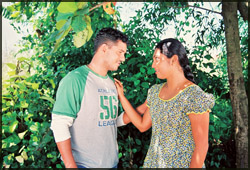
Amila Abeysekara and Manjula Thilini |
Was it epoch making history? Or was it history making history?
Hatharadenama Soorayo, the popular film of 1971 which starred a legend
of the Sinhala cinema Gamini Fonseka, produced and directed by the
affable Neil Rupasinghe created history in a film remake only second to
the Hollywood film industry named “God Created Woman” by Roger Wadim.
Hatharadenama Soorayo is the second in the history of film industry
in the world that the same Producer and Director did a re-make of the
same film after 37 years with the same theme creating a world record.
The original cast Hatharadenama Soorayo had outstanding actors of the
calibre of Gamini Fonseka, the romantic Vijaya Kumaratunga, Anthony C
Perera and Senadeera Rupasinghe with the most intelligent actress of the
Sinhala film industry Malini Fonseka in the female lead.
Rupasinghe recently created history in the Sri Lankan film industry
being the same producer and director of the film Hatharadenama Soorayo
which had four youngsters like Buddhika Jayarathne in Gamini’s role,
Roshan Pilapitiya for Vijaya Kumarathunga’s role, Jagath Chamila did an
Anthony C Perera and Amila Abesekara took over Senadeera’s place in the
cast.
|
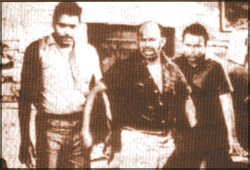
1971 version of Hathara Denama Soorayo. Picture courtesy Nuvan
Nayanajith |
Chathurika Peiris was chosen to play the role of Malini Fonseka and
Kanchana Mendis in the supporting role earlier played by Sriyani
Amarasena. Also in the female cast were Manjula Thilini and Nadeesha
Alahaperuma.
37 years later Rupasinghe who created history by the remake of the
film was a proud man, who had this to say: “The film was reproduced and
directed by me not with the wish of creating any records. But to keep
the theme of the film alive with youngsters in the cast”. He, however
lamented that it was difficult to replace legendary men and actors like
Gamini Fonseka, Vijaya Kumaratunga, Anthony C Perera and Senadeera
Rupasinghe who played the prominent roles in the film.
Buddhika Jayarathne who played the role of Gamini Fonseka did his
best but one can’t expect the same from him as we saw in the legendary
man Gamini Fonseka as an actor.
Another feature in the remake of this film was the new technical
effects introduced with the advanced technology with slight changes to
sound, editing, creative fighting and lighting.
|
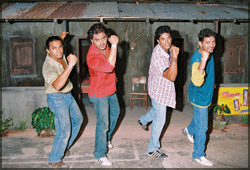
Hathara Denama Soorayo 2008 version - Jagath, Buddhika, Roshan
and Amila. |
The remake of the film, according to Neil Rupasinghe had cost a
staggering 15 million with a shooting duration of 90 days.
Technical operation of the film clearly defines the difference
between the mini screen and the larger screen. Up and coming producers
Lalantha Watudura and Malcom Stanislaus, a Dentist by profession
assisted Neil Rupasinghe in the product of film, Hatharadenama Soorayo.
The new version of the film however, sadly lacks the personality and
looks of a Vijaya Kumaratunga and character and charm of a Gamini
Fonseka.
The roles of the female partners come close to the original actors
but a void could still not be ignored.
Perhaps it is also due to the elements such as the surroundings,
locations and dialogues of those of the original cast.
The Bridge on the River Kwai:
One of the greatest war epics
Asoka WEERAKOON
|
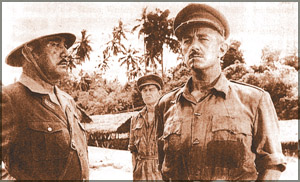
Sassue Hawakawa as the Japanese PoW Commandant and Oscar winning
Sir Alec Guinness as Colonel Nicholson.
|
The 80th Hollywood Oscar Awards was scheduled for the February 24
despite the ongoing strike by the Screen Writers’ Guild. Looking back
half a century. The 1958 ceremony was of great significance to Sri
Lanka.
The movie “The Bridge on the River Kwai” won seven Oscars: best
picture, director, actor, and the awards for cinematography, editing,
score and screenplay.
Directed by the master movie maker Sir David Lean it starred the
brilliant Sir Alec Guinness, William Holden, Jack Hawkins and Sessue
Hayakawa.
The picture was shot in Sri Lanka in 1956 mainly in Kitulgala and
Ambepussa. Many Burgher boys were taken in as extras to play the British
PoWs. One in particular attained a sort of immortality by whistling the
“Colonel Boogie March” when asked by a production executive to hum
collectively to lighten up the laborious march. This was retained in the
completed picture as a part of the award winning score.
The writer was in his late teens then and was at some location sites
watching some of his colleagues in action and marvelled at the magic of
movie making.
The most interesting was the Studio publicity boys and their advance
handouts with flamboyant prose screaming away exotic yarns.
One example: “ peasants fled in terror today [08.11.1956] as para-troopers
descended on a village. They set the temple bells ringing to signal the
start of an invasion. Police were called to explain.
Another: “When shooting commenced at Ambepussa (village of the
mangoes) the local headmaster declared a half-holiday and the ring-side
seats were taken by mothers nursing babies at their breasts, old timers,
many of them centenarians, farmers and herdsmen, and even the village
constable...” But the imaginative publicity hacks failed to christen
Kitulgala, “Stone of Nectar,” or by some such name!
Whatever the blurbs and pulp fiction of the Hollywood rhapsodists,
“The Bridge” remains one of the greatest war epics ever made along with
such classics as “All Quiet on the Western Front” and “Paths of Glory”
Contemporary Chinese Cinema explores varied themes
K.S. Sivakumaran
|
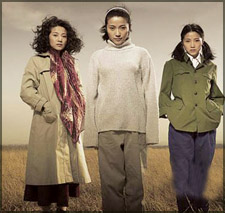
Scenes from ‘Teeth of Love’
|
It is amazing to note and witness the contemporary Chinese Cinema as
it comes out of the box, as it were, to explore varied themes far from
the regimented orientation of the past decades. It is a welcome move and
sign indeed.
I happen to watch many such films from that country both in Panaji (Goa
in India) and Thiruvananthapuram (also in India) late last year. Among
them was a film called Teeth of Love directed by Zhuang Yuxin, who
teaches at the Beijing Film Academy.
Here is a brief note on the film: The film is really a study of
character of a particular young woman (played admirably by Yan Bingyan).
This character’s development against the backdrop of economic and social
change in China after the Mao regime is unbelievable and shockingly
realistic.
Her story begins with her tomboy bullying teenager in the 1970s and
taking a tough stance as a card carrying political member. She then
becomes a doctor in a rural hospital and has an affair with a patient
who was married.
She is amorous in her sexual passion - a change from her bullying
nature at the beginning. She returns to Beijing and gets married to a
shy man. They have a child, but she is sad and not happy. She becomes
matured.
 The film is neither sentimental nor melodramatic. There is restraint
atmosphere. It’s a kind of Brechtian atmosphere. At the beginning of the
film I felt bad of her daring behaviour, but as the story developed I
showed signs of empathy towards her. Indeed she becomes an interesting
character. The film is realistic in that it shows the unwelcome traits
in her character turning into self realization. The film is neither sentimental nor melodramatic. There is restraint
atmosphere. It’s a kind of Brechtian atmosphere. At the beginning of the
film I felt bad of her daring behaviour, but as the story developed I
showed signs of empathy towards her. Indeed she becomes an interesting
character. The film is realistic in that it shows the unwelcome traits
in her character turning into self realization.
Her character development comes to fruition when she turns a complete
woman at the end, after suffering mostly because of her wrong doings.
The abortion scene where she herself performs on her with a little
help from her former married friend is shockingly nauseating. She had
had relationships with three men during a period of 10 years and each
episode is excruciatingly painful to her and to the audience as well.
For most orthodox viewers the film may be weird.
However, I enjoyed the film for its cinematic potentialities. This is
the director’s first film although he had achieved laurels as a
television film maker.
[email protected]
Jodhaa Akbar in a whopping 1500 theatres worldwide
|
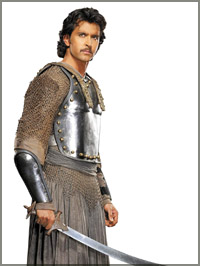
Aishwarya and Hrithik as Rajput princess Jodhaa and the Mughal
Emperor Akbar
|
Jodhaa Akbar, the epic romance between Mughal Emperor Akbar and the
fiery Rajput princess Jodhaa is screening at Liberty Cinema.
Directed by Academy Award nominated director, Ashutosh Gowariker, the
movie stars Aishwarya Rai Bachchan and Hrithik Roshan and was released
across 26 countries in USA, Europe, Asia and Middle East. The film is
dubbed in 3 languages - Hindi, Telegu, Tamil; and subtitled in English,
Arabic and Dutch. It is viewed across 1500 screens worldwide making it
the biggest release ever for an Indian film.
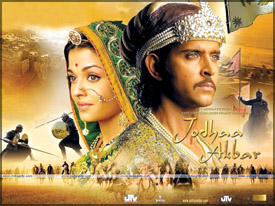 In India alone the film was released in more than 1200 screens of
which 500 are through digital cinemas and 825 through physical prints. In India alone the film was released in more than 1200 screens of
which 500 are through digital cinemas and 825 through physical prints.
In the US, the film is released on close to 122 prints, the highest
ever for an Indian film.]
Set in the 16th century, the epic movie begins with a marriage of
alliance between two cultures and religions, for political gain, with
King Bharmal of Amer giving his daughter’s hand to Emperor Akbar.
When Akbar accepts the marriage proposal, little does he know that in
his efforts to strengthen his relations with the Rajputs, he would in
turn be embarking on a new journey- the journey of true love.
From the battlefield where the young Jalaluddin was crowned, through
the conquests that won him the title of Akbar the Great, to winning the
love of the beautiful Jodhaa. Jodhaa Akbar traces the impressive graph
of the mighty emperor and his romance with defiant princess.
|

